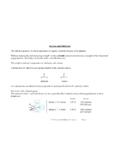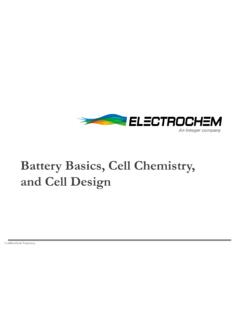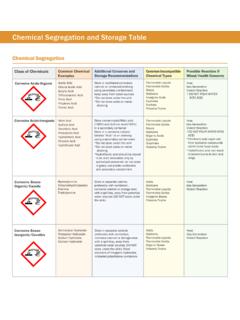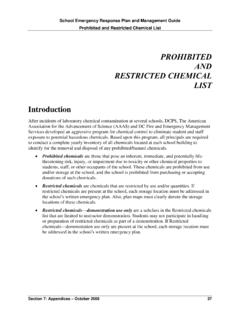Transcription of Battery Room Ventilation and Safety - CED Engineering
1 Battery Room Ventilation and Safety Course No: M05-021 Credit: 5 PDH A. Bhatia Continuing Education and Development, Stonewall CourtWoodcliff Lake, NJ 07677P: (877) Room Ventilation and Safety 1 Battery ROOM Ventilation AND Safety It is common knowledge that lead-acid batteries release hydrogen gas that can be potentially explosive. The Battery rooms must be adequately ventilated to prohibit the build-up of hydrogen gas. During normal operations, off gassing of the batteries is relatively small. However, the concern is elevated during times of heavy recharge or the batteries, which occur immediately following a rapid and deep discharge of the Battery . Often the HVAC designers underestimate the worst case for dangerous hydrogen accumulation, and often display reassuring calculations proving that no danger really exists.
2 But dismissing such a critical Safety issue is not a safe or responsible way to deal with it. Instead, we should be prepared to face the likely possibility of hydrogen build up, clearly identify the conditions when the risk is highest, and design systems that protect us from explosive levels in a fail-safe way. This course describes the hazards associated with batteries and highlights those Safety features that must be taken into consideration when designing, constructing and fitting out a Battery room. It provides the HVAC designer the information related to cost effective Ventilation . The course is only for reference and anyone using this course should rely on state and local codes that may apply. Advice on specific Ventilation rates required must be sought from the Battery suppliers.
3 This course is applicable to facility professionals, architects, electrical, mechanical and HVAC engineers, controls engineers, contractors, environmentalists, energy auditors, O& M professionals and loss prevention professionals. The course is divided into 5 chapters: 1. Fundamentals of Lead-acid Battery 2. Rules and Regulations 3. Ventilation Calculations 4. Battery Room Design Criteria 5. Preparation and Safety Do s and Don t s Once you complete your course review, you need to take a multiple-choice quiz consisting of twenty five (25) questions based on this document. Battery Room Ventilation and Safety 2 CHAPTER -1 FUNDAMENTALS OF LEAD-ACID BATTERIES The function of the Battery is to store electricity in the form of chemical energy and when required to convert it to electrical energy.
4 Electrical energy can be produced from two plates immersed in a chemical solution. When several are linked, they give a higher capacity. Battery cells can be divided into two major types: Primary cell: It is one that cannot be recharged and is discarded at the end of its life. Secondary cell: It is one that is rechargeable. Examples of primary cells include carbon-zinc (dry cell), alkaline-manganese, mercury-zinc, silver-zinc, and lithium cells ( , lithium -manganese dioxide, lithium -sulfur dioxide, and lithium - thionyl chloride). Examples of secondary cells include lead-lead dioxide (lead-acid), nickel-cadmium, nickel-iron, nickel-hydrogen, nickel-metal hydride, silver-zinc, silver-cadmium, and lithium -ion. Lead-acid Battery Lead-acid Battery is a type of secondary Battery which uses a positive electrode of brown lead oxide (sometimes called lead peroxide), a negative electrode of metallic lead and an electrolyte of sulfuric acid (in either liquid or gel form).
5 The overall cell reaction of a typical lead-acid cell is: The three major contributors to Lead-acid Battery chemistry are lead, lead dioxide, and sulfuric acid. Unfortunately pure lead is too soft to withstand the physical abuse; about 6% antimony is added to strengthen it. Historically, antimony added to the lead grids, acted as a catalyst and made out gassing (loss of hydrogen and oxygen during use) worse, and frequent water replenishing was required. So Battery manufacturers looked for another material that could strengthen the lead grids. Calcium was added to both the positive and negative electrodes. It reduced out gassing enough to allow manufacturers to claim they are building "maintenance-free batteries". Battery Room Ventilation and Safety 3 Alkaline Battery (Nickel-Cadmium Battery ) An alkaline storage Battery has an alkaline electrolyte, usually potassium hydroxide (KOH), and nickel oxide (nickel oxy-hydroxide) as positive electrode and metallic Cadmium as negative electrode.
6 The overall cell reaction is: The nominal cell voltage = + When compared to lead-acid batteries, Nickel Cadmium loses approximately 40% of its stored energy in three months, while lead-acid self-discharges the same amount in one year. Lead-acid work well at cold temperatures and is superior to the lithium -ion when operating in sub-zero conditions. The Lead-acid Battery is the most popular type used and we will focus on it in this course. Components of Lead-Acid Battery The Lead-acid Battery basically consists of the following four (4) components: 1. Case 2. Terminals 3. Plates 4. Electrolyte Battery Room Ventilation and Safety 4 Case The Battery case is constructed of insulating, acid resistant material usually plastic or hard rubber and has a number of compartments or cells. A 12-volt Battery has 6 cells.
7 Recesses in the bottom of the cells collect the sediment that falls from the plates. This prevents the sediment from bridging the plates and causing an internal short-circuit. The top of the plate assembly is enclosed by a moulded one-piece cover which is sealed to the main case. Each cell has a removable plug to facilitate topping up and testing. These plugs are vented to allow for the escape of gases produced during charging. Terminals Positive pole: shown + usually red in color and is the larger of the two. Negative pole: shown usually black or green and is the smaller of the two. Battery connectors: Various types of connectors are shown below: Battery Room Ventilation and Safety 5 Plates Batteries are composed of one or more cells; each cell has a number of positive and negative plates with separators fitted between them.
8 The total number of plates per cell is normally not less than seven, usually starting and finishing with a negative plate. The surface area of the plates in a cell determines its current capacity. In a lead-acid Battery , the plates are assembled so there is always one extra negative plate. The plates are close to each other but do not touch, which would cause a short-circuit. One set of plates is connected to the negative side of a DC source, the other to the positive side. Direct current is applied to the plates, changing them chemically, until the Battery is ready for service. The nominal voltage of a cell is 2 volts. Cells connected in series make a Battery , and the number of cells determines its nominal voltage. The accepted, or nominal, voltage of a cell does not depend on the size of the cell.
9 The size of the cells determines the discharge capacity (current capacity) of the entire Battery . Battery Room Ventilation and Safety 6 Each cell has its own vent cap designed to relieve excess pressure and allow gases to escape. It also keeps the dust and dirt out of cells and contains electrolyte solution inside the Battery cell. Electrolyte The Battery is filled with electrolyte, which is a mixture of 35% sulfuric acid and 65% de-ionized water. The separators between the plates are porous to allow the circulation of the electrolyte, and the chemical action to take place. When the cell is functioning, the acid reacts with the plates, converting chemical energy into electrical energy. Electrical current flows from one pole of the Battery , through the circuit, and back to the Battery . Discharging In a fully-charged Battery the positive plates are made of lead peroxide and the negative plates are spongy lead.
10 During discharge or use: Sulphur in the acid combines with the plates to form lead sulphate; and The oxygen and hydrogen released combine to form water, which dilutes the electrolyte. As the Battery is discharged, or used, the acid concentration decreases and becomes weaker (dilute) until the Battery cannot produce an electrical current. This makes it possible to tell the state of charge by seeing how weak the electrolyte is. A hydrometer is used to measure the strength of the electrolyte. Both negative and positive plates become lead sulphate as the Battery is discharged by use. The resulting lead sulphate is bulkier than spongy lead or lead peroxide, so if the Battery is discharged too quickly the plates will buckle and some paste will fall out. This shortens the life of the Battery .
















